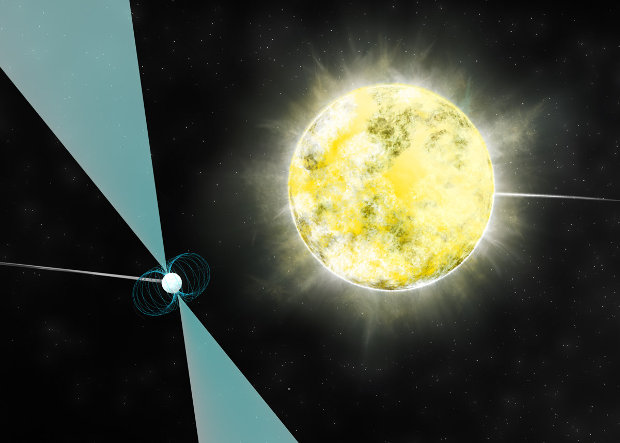
Astronomical research are getting us used to really bizarre discoveries and sometimes astronomers can truly say they found a jewel in space. In the past, the analysis of the planet 55 Cancri e led to theorize that part of it is a huge diamond, now a team of astronomers has identified a white dwarf that may have turned into a diamond the size of the Earth.
White dwarfs are what remains after the death of stars that have a mass similar to the Sun. Their gravity, no longer opposed by nuclear reactions, makes them a size similar to the Earth. Their residual heat dissipates slowly into space so their light becomes dimmer and dimmer.
Sometimes, a white dwarf is discovered because it has another star as a companion and the gravitational influence on it allows astronomers to detect its presence. In this case, Jason Boyles of West Virginia University in Morgantown discovered a pulsar, all that remains after the supernova that causes the death of a star more massive than the Sun, called PSR J2222-0137.
Thanks to the observations of PSR J2222-0137, made using NRAO (National Radio Astronomy Observatory) GBT (Green Bank Telescope), it was possible to note that this pulsar had a gravitational bond with a companion. Data showed that the two objects orbit around each other in 2.45 days but the GBT wasn’t enough for an accurate analysis.
Adam Deller, an astronomer at ASTRON, the Netherlands Institute for Radio Astronomy, observed the pulsar PSR J2222-0137 for over two years using the VLBA (Very Long Baseline Array), an array that combines data from ten telescopes spread across the USA. These observations revealed that the pulsar and its companion are about 900 light-years away from Earth.
The application of the theory of relativity allowed astronomers to study how the gravity of the companion warped space causing a delay in the radio signals emitted by the pulsar when it passed behind it. This allowed to establish that the pulsar has a mass 1.2 times that of the Sun while its companion has a mass 1.05 times that of the Sun.
Knowing the position of the companion, the telescopes SOAR (Southern Astrophysical Research) in Chile and the Keck in Hawaii were used to try to see it but with no success. The orbits of the two objects are too ordered so there couldn’t have been a second supernova and therefore the companion must be a white dwarf.
Astronomers have concluded that to be so dim that it can’t even be seen by telescopes, its temperature can’t be above 3,000 degrees Kelvin, that is about 2,700 degrees Celsius or about 4,900 degrees Fahrenheit. For a star, even one that reached the end of its life, it’s a very low temperature.
White dwarfs are typically composed mostly of oxygen and carbon and at temperatures as those of the star examined carbon can crystallize becoming a huge diamond. In this case, the white dwarf is probably around 11 billion years old, which is the same as the Milky Way.
An article describing the results of this research has been published in the journal “Astrophysical Journal”. According to astronomers, such cases in theory aren’t rare but are difficult to detect. White dwarfs of this type are so dim that to be found they must be relatively close to Earth or, as in this case, have a companion that betrays their presence. The universe may be full of huge diamonds.
[ad name=”AmazonDocumentary”]

